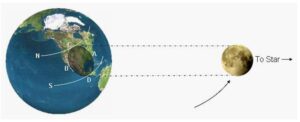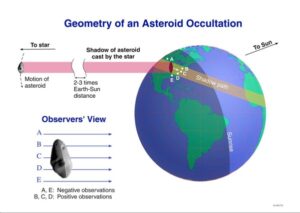What is an Occultation?
An occultation occurs when a solar-system body passes in front of a more distant object (e.g. a star or another solar system body), partially or totally hiding the more distant object and momentarily blocking its light. Each occultation can be seen only at the right time and from a limited part of the Earth. IOTA primarily observes two basic areas of occultation astronomy: lunar occultations and asteroid occultations.
Lunar Occultations
Observing lunar occultations tends to be fun and easy to learn. These events do provide novice observers with a training tool from which they can make timings using visual means or more advanced methods such as with video. Lunar occultations are more easily observed by those with small telescopes or less experience. The Moon makes a very convenient guide to identifying the area in the sky in which to find the star which is to be occulted. Lunar occultations can be classified into two groups: total lunar occultations and grazing lunar occultations. In a total lunar occultation the observer will see only one occultation event, either a disappearance of the star as the moon passes in front of the star or a reappearance of the star as the moon moves away from in front of the star. In a grazing lunar occultation, the very edge of the moon passes in front of the star and the star may disappear and reappear many times as the mountains on the edge of the moon individually occult the star. The diagram below depicts the geometry of total and grazing lunar occultations. As the Moon moves in its orbit, its projection on Earth results in a total lunar occultation of the star for those observers between points C and D, while a grazing lunar occultation of the star occurs at points C and D or anywhere along lines N and S.

Lunar occultations are ideally suited for small telescopes since they do not require locating a faint star in the sky. To observe a total lunar occultation of a star, simply find the Moon and locate the position along the edge of the lunar surface where the star is predicted to be as the moon moves in front of it. The star should then be easily visible. Since the Moon moves to the East across the sky, the first two weeks of the Lunar cycle is the best time to observe a star’s disappearance, since the leading edge of the Moon is not illuminated by the Sun until after Full Moon. Similarly, the last two weeks of the Lunar cycle is the best time to observe the reappearance of a star as the Moon uncovers it since the trailing edge of the Moon will be dark during this period. Beginners should start by observing total lunar occultations (which occur nightly from nearly everywhere on Earth) and then graduate to observing grazing occultations at the north or south poles of the Moon. Grazing occultations usually require the observer to travel to a specific location because a grazing occultation occurs only along the edges of the moon’s occultation path. In addition, the zone of “grazing” is often limited to only a few kilometers within the edge of the moon’s occultation path. Observing a graze requires careful planning and precise locations. Traditionally, most grazing occultation observations have been done in teams to generate a more detailed profile of the edge of the moon.
Asteroid Occultations
For asteroid occultations the star is usually the brightest component of the occultation. The asteroid is usually several magnitudes fainter than the star and often too faint to be detected in a small telescope. In an asteroid occultation, the observer must find the star to be occulted and monitor the star to watch for any drop in brightness that would signal an occultation. Asteroid occultation events typically last several seconds but may observers may record much shorter or much longer events in rare cases. In the following diagram of an asteroid occultation: As the asteroid moves in its orbit, a shadow is created from light cast by the star about to be occulted. The shadow (equal in size to the asteroid) then moves across the Earth (diagram not to scale). An observer will only see an event (drop in the brightness of the star) if they are located inside the path of the asteroid’s shadow. Since asteroids are generally much smaller than the moon, choosing a location for observing an asteroid occultation is more important than location in lunar occultations. In addition, asteroid subtend a much smaller angular size on the sky and this leads to more uncertainty in the actual location of the asteroid’s shadow. Asteroid occultation predictions posted by IOTA provide information on the expected location of the shadow path, expected time of the occultation, the level of drop in the star’s light and the expected duration of the occultation event. An observer can expect to see a single disappearance (or drop in starlight) and a single reappearance though it is possible to see step events.
Note in the diagram above that multiple observers span the shadow of the asteroid. In this way an outline of the actual shape of the asteroid can be determined – information that would be difficult or impossible to obtain in any way other than by visiting the asteroid itself!
What should an Observer expect to see during an occultation?
A total lunar occultation will result in the star disappearing once, then reappearing tens of minutes later. For lunar grazing occultations, an observer should expect to see the star continuously as it approaches the lunar limb, then intermittently as it moves by changing topographic features, then continuously again as the Moon completely passes by. The sequence of events typically lasts from less than one minute to perhaps 2-4 minutes. Predictions of lunar grazing events are generally quite accurate; the idea is to accurately time each disappearance, blink, dimming, reappearance and any other optical phenomena visible during the graze. This is best and most accurately accomplished with a sensitive surveillance-grade video camera attached to a telescope since the human eye/brain combination cannot react fast enough in the case of rapidly occurring activity. Step events (where the star’s brightness does not drop or return instantly) may also be detected. Such events may be a signal of a double star. As can be seen in the earlier diagram of the projection of the Moon’s limb onto the Earth’s surface, a team of observers are needed to map the entire limb. They should be spread out perpendicular to each other to cover the entire lunar mountain range.
In an asteroid occultation, the asteroid will move close the target star, merging into one slightly brighter object, the combined object will dim to the magnitude of the asteroid alone as the asteroid passes in front of the target star, the object will return to the combined brightness as the asteroid passes beyond the star, and eventually the asteroid will move away from the star as a separate object. In most asteroid occultations the asteroid will be very dim (mag 15 or dimmer). In this case, the observer will probably not see the asteroid as a separate object and the star will disappear completely during the occultation. In some events, the asteroid is bright enough to observe its motion separately. And it some events the asteroid is actually brighter than the star. In these “low mag drop” events, the magnitude of the combined object will drop only slightly during the occultation. Observers must use video cameras or CCD camera to successfully observe these events.
Some asteroids actually have one or more satellites (also known as moons) orbiting them. As the asteroid moves in its orbit, it projects a shadow across Earth. Rarely, an unknown asteroid moon moving with it creates opportunity for discovery. Such secondary occultations should be expected to occur within +/- one minute of the actual asteroid occultation and be of very short duration, perhaps a fraction of a second and may be quite distant from the predicted asteroid shadow line. For this reason, if you cannot travel you should consider observing an asteroid occultation even if you are some distance from the predicted shadow line. You may be the person who discovers a new moon of the asteroid!

